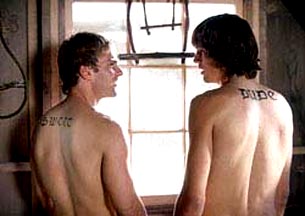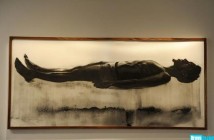Does an artist have the responsibility to explain his/her work? Can the work exist as an entity unto itself? We are trained as artists to think critically about what we make, what we see and the world in which we involve ourselves. This is all very internal. These intellectual investigations are not made evident until the work of art is constructed and displayed. But is this enough? Is it not our job to explain our work, to explain the conceptual processes that have taken place? What if the artist is unable to comment on the work? Does it lessen the appeal or conceptual grounding of the art?
I ask this because in my time at the School of the Museum of Fine Arts I had the opportunity to hear many artists speak of their work. Some were extremely erudite and made me want to revisit their work with an eye towards gaining a greater sense of them as artists. While others left me thinking I would have been better off watching “Dude, Where’s My Car” as the linguistic similarities were both frightening and much less entertaining. Is the ability to coherently and engagingly discuss one’s art crucial to being an artist? Perhaps a better question is, is it crucial to one’s success as an artist?
It would seem that the easiest thing to do would be to put the work out there (wherever that may be; the web, a gallery, a public space) and let it stand on its own merits as a “work of art.” For the viewer reading a work of art is a personal experience. We see it, examine it, read it, and touch it irrespective of the creator. One’s experience with a work of art is relative to one’s personal cultural narrative and the ways in which art has played a role in that narrative. What complicates this experience is that often the work of art is extremely coded around the artist’s personal vision relative to their intellectual pursuit and lived experience. It is simply impossible to “get” everything that a work of art is about in a one to one viewing experience. There are some aspects that are beyond one’s ability to receive. Often this chore is placed in the hands of the curators and critics. However, the artist has to play a role in the explanation of the work which brings me to the moment that prompted this essay.
Several weeks ago I was walking past the ICA and noted the poster for the current show “Getting Emotional.” There is an artist included in the show that I have had personal experience with. I will refrain from naming the artist. This particular person stuck in my mind as he/she has had great success in the past three or so years, having appeared in the Whitney Biennial and numerous group shows. The work is quite stunning visually; the experience of listening to this person attempt to explain the work is another matter entirely. I have never had a more painful experience with an artist lecture. I couldn’t tell whether it was an inability to discuss or unwillingness. This person has an advanced degree from a seemingly reputable institution that has produced numerous “art stars.” The lecture (a term used very loosely here) consisted of watching the work and then watching the artist struggle with the fact that s/he had to talk about it. From a pedagogical standpoint, we as listeners learned absolutely nothing about the work other than it was made, it has been shown and it continues to be shown.
Speaking publicly is an art form all on its own. There are reasons why certain people become extremely successful and powerful through speech giving. The ability to move and provoke orally seems almost as innate a talent as painting or sculpting etc. However much like these art forms it can also be a learned skill. One gets better and more comfortable at it through practice. It was at the School of the Museum of Fine Arts that I got quite adept at talking about my work and describing my thought processes to my peers. I personally feel that constant peer review and questioning enable me to talk about my work in a manner that allows others to respond much deeper to it. The flipside of this experience being that I was witness to numerous painful review boards with those who just couldn’t talk about their work at all. What is missing in the art school experience is serious training in how to talk about one’s work. The key is getting those people who sit alone in their studio, never engaging in a conversation, to learn how to do this.
When my work leaves and enters the “world” I am not there to explain it. It exists as a piece of art contextualized by my artist statement (if that) and nothing else. Ultimately is seems that the art has to stand on its own without any explanations other than the personal ones the viewers bring with them. You can never be everywhere your art is. But I feel that the ability to talk about your work, explain it coherently and bring people closer in the event that you are on hand to do so, is crucial, if not to be “successful” commercially, then at the very least successful in engaging others in the experience that you wish people to have with your art. I will never look at their (the person mentioned above) art the same way again. I will see it as a visual trick with nothing deeper than an “it looks cool” attitude. Because that was all they seemed to want to convey to me. Is that a bad thing? Perhaps not but some of us strive for more. I strive to make people think and talk about issues that perhaps haven’t occurred to them. I wish to make experiences that prompt conversation. Sure I also want it to look cool, but in the end that only takes you so far and lasts so long.
- Speak – lest ye be spoken for behind the scenes
- Dude, how’s my art?’ ‘Sweet, how’s mine look?’
All images are courtesy of Creative Screen Writing and metacool.






